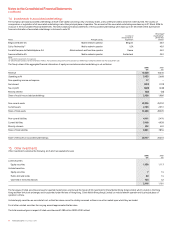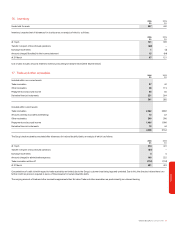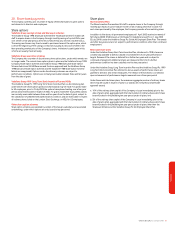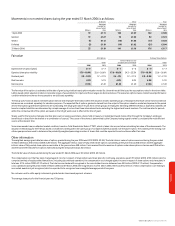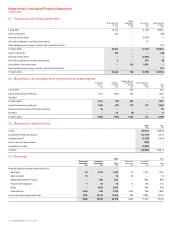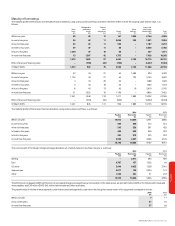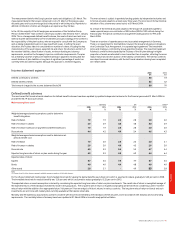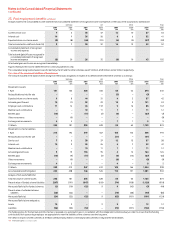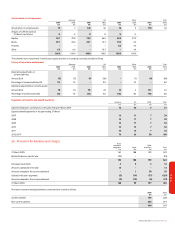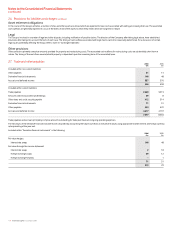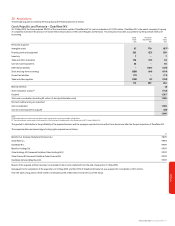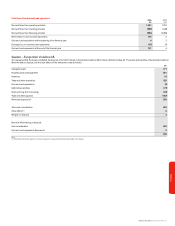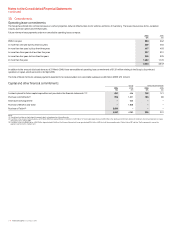Vodafone 2006 Annual Report Download - page 108
Download and view the complete annual report
Please find page 108 of the 2006 Vodafone annual report below. You can navigate through the pages in the report by either clicking on the pages listed below, or by using the keyword search tool below to find specific information within the annual report.
106 Vodafone Group Plc Annual Report 2006
Notes to the Consolidated Financial Statements
continued
24. Borrowings continued
Financial risk management
The Group’s treasury function provides a centralised service to the Group for funding,
foreign exchange, interest rate management and counterparty risk management.
Treasury operations are conducted within a framework of policies and guidelines
authorised and reviewed annually by the Company’s Board of directors, most recently on
31 January 2006. A Treasury Risk Committee, comprising of the Group’s Chief Financial
Officer, Group General Counsel and Company Secretary, Group Treasurer and Director of
Financial Reporting, meets quarterly to review treasury activities and management
information relating to treasury activities. In accordance with the Group treasury policy, a
quorum for meetings is four members and either the Chief Financial Officer or Group
General Counsel and Company Secretary must be present at each meeting. The Group
accounting function, which does not report to the Group Treasurer, provides regular
update reports of treasury activity to the Board of directors. The Group uses a number of
derivative instruments that are transacted, for risk management purposes only, by
specialist treasury personnel. The Group’s internal auditors review the internal control
environment regularly. There has been no significant change during the financial year, or
since the end of the year, to the types of financial risks faced by the Group or the Group’s
approach to the management of those risks.
The Group’s policy is to borrow centrally, using a mixture of long term and short term
capital market issues and borrowing facilities, to meet anticipated funding requirements.
These borrowings, together with cash generated from operations, are on-lent or
contributed as equity to certain subsidiaries. The Board of directors has approved three
debt protection ratios, being: net interest to operating cash flow (plus dividends from
associated undertakings); retained cash flow (operating cash flow plus dividends from
associated undertakings less interest, tax, dividends to minorities and equity dividends)
to net debt; and operating cash flow (plus dividends from associated undertakings) to
net debt.
These internal ratios establish levels of debt that the Group should not exceed other
than for relatively short periods of time and are shared with the Group’s debt rating
agencies, being Moody’s, Fitch Ratings and Standard & Poor’s.
Liquidity risk
As at 31 March 2006, the Group had $10.9 billion committed undrawn bank facilities and
$15 billion and £5 billion commercial paper programmes, that are supported by the
$10.9 billion committed bank facilities, available to manage its liquidity.
Market risk
Interest rate management
Under the Group’s interest rate management policy, interest rates on monetary assets
and liabilities are maintained on a floating rate basis, unless the forecast interest charge
for the next eighteen months is material in relation to forecast results, in which case
rates are fixed. In addition, fixing is undertaken for longer periods when interest rates are
statistically low.
At 31 March 2006, 29% (2005: 31%) of the Group’s gross borrowings were fixed for a
period of at least one year. A one hundred basis point fall or rise in market interest rates
for all currencies in which the Group had borrowings at 31 March 2006 would increase or
reduce profit before tax by approximately £91 million, including mark-to-market
revaluations of interest rate and other derivatives and the potential interest on
outstanding tax issues.
Foreign exchange management
As Vodafone’s primary listing is on the London Stock Exchange, its share price is quoted
in sterling. Since the sterling share price represents the value of its future multi-currency
cash flows, principally in euro, yen (until disposal of its Japan operation on 27 April
2006), sterling and US dollars, the Group has a policy to hedge external foreign
exchange risks on transactions denominated in other currencies above certain de
minimis levels.
The Group also maintains the currency of debt and interest charges in proportion with
its expected future principal multi-currency cash flows. As such, at 31 March 2006,113%
of net debt was denominated in currencies other than sterling (73% euro, 21% yen, 14%
US dollar and 5% other), whilst 13% of net debt had been purchased forward in sterling
in anticipation of sterling denominated shareholder returns via share purchases,
dividends and B share distribution. This allows debt to be serviced in proportion to
expected future cash flows and, therefore, provides a partial hedge against income
statement translation exposure, as interest costs will be denominated in foreign
currencies. A relative weakening in the value of sterling against certain currencies in
which the Group maintains debt has resulted in an increase in net debt of £182 million
from currency translation differences.
When the Group’s international net earnings for the year ended 31 March 2006 are
retranslated assuming a 10% strengthening of sterling against all exchange rates, the
operating profit for the year would have increased by £1,344 million (2005: reduced by
£645 million), and would have been reduced by £1,642 million (2005: increased by
£789 million) if sterling weakened by 10%.
The change in equity due to a 10% fall or rise in sterling rates against all exchange rates
for the translation of net investment hedging instruments would be a decrease of
£1,669 million or an increase of £1,365 million. However, there would be no net impact
on equity as there would be an offset in the currency translation of the foreign
operation.
Credit risk
The Group considers its maximum exposure to credit risk to be as follows:
2006 2005
£m £m
Bank deposits 948 343
Money market fund investments 1,841 2,708
Commercial paper investments –512
Repurchase agreements –206
Derivative financial instruments 310 408
3,099 4,177
Concentrations of credit risk with respect to trade receivables are limited due to the
Group's customer base being large and unrelated. Due to this, management believes
there is no further credit risk provision required in excess of the normal provision for bad
and doubtful receivables (note 17).
The deposits shown in the table equate to the principal of the amount deposited. The
foreign exchange transactions and interest rate swaps shown in the table have been
marked-to-market.
For repurchase agreements, collateral equivalent to the investment value is satisfied by
triple-A rated government and/or supranational instruments and collateral is
replenished on a daily basis. In respect of financial instruments used by the Group’s
treasury function, the aggregate credit risk the Group may have with one counterparty is
limited by reference to the long term credit ratings assigned for that counterparty by
Moody’s, Fitch Ratings and Standard & Poor’s. While these counterparties may expose
the Group to credit losses in the event of non-performance, it considers the possibility of
material loss to be acceptable because of this policy.
Consistent with development of its strategy, the Group is now targeting low single A long
term credit ratings from Moody’s, Fitch Ratings and Standard & Poor’s having previously
managed the capital structure at single A credit ratings. Credit ratings are not a
recommendation to purchase, hold or sell securities, in as much as ratings do not
comment on market price or suitability for a particular investor, and are subject to
revision or withdrawal at any time by the assigning rating organisation. Each rating
should be evaluated independently.
25. Post employment benefits
Background
As at 31 March 2006, the Group operated a number of pension plans for the benefit of
its employees throughout the world, which vary depending on the conditions and
practices in the countries concerned. The Group's pension plans are provided through
both defined benefit and defined contribution arrangements. Defined benefit schemes
provide benefits based on the employees' length of pensionable service and their final
pensionable salary or other criteria. Defined contribution schemes offer employees
individual funds that are converted into benefits at the time of retirement.
The principal defined benefit pension schemes are in the United Kingdom and Germany.
The Group also operated defined benefit schemes in Japan, its discontinued operation,
and in Sweden until it was disposed of on 5 January 2006. In addition, the Group
operates defined benefit schemes in Greece, Ireland, Italy and the United States. Defined
contribution pension schemes are provided in Australia, Belgium, Egypt, Germany,
Greece, Hungary, Ireland, Italy, Malta, the Netherlands, New Zealand, Portugal, Spain, the
United Kingdom and the United States. A defined contribution scheme is also operated
in the Group’s discontinued operation in Japan. There is a post retirement medical plan
in the United States for a small closed group of participants.
The Group accounts for its pension schemes in accordance with IAS 19, Employee Benefits
(“IAS19”). The Group has also early adopted the amendment to IAS 19 that was published
in December 2004 regarding actuarial gains and losses, group plans and disclosures.
Scheme liabilities are assessed by independent actuaries using the projected unit
funding method and applying the principal actuarial assumptions set out below. Assets
are shown at market value.


